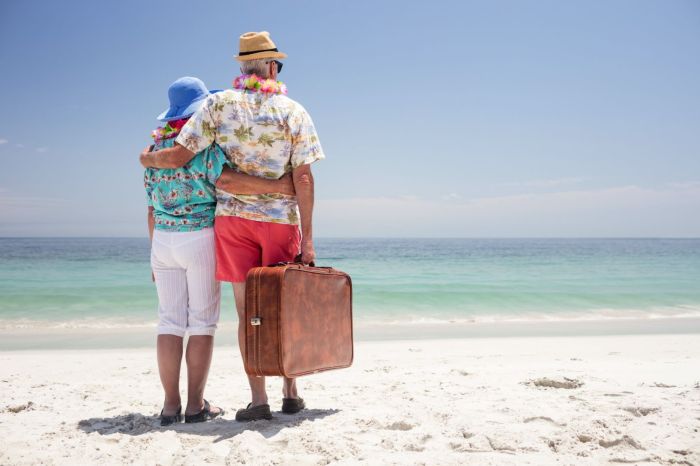Senior Citizen Trips represent a burgeoning market, offering tailored experiences for active retirees seeking adventure, relaxation, cultural immersion, or historical exploration. This guide delves into the diverse options available, addressing logistical considerations, accessibility challenges, health and safety concerns, budgeting strategies, and the profound social and emotional benefits of travel in later life. From meticulously planned itineraries to navigating accessibility issues and maximizing travel budgets, we provide a comprehensive roadmap for unforgettable senior adventures.
Whether it’s a relaxing Caribbean cruise, a culturally rich European tour, or an adventurous trek through the Swiss Alps, the right trip can rejuvenate, connect, and create lasting memories. We examine the nuances of various trip types, offering practical advice and resources to ensure a seamless and enriching experience for every senior traveler.
Types of Senior Citizen Trips

The travel industry increasingly caters to the needs and desires of the senior citizen demographic, offering a diverse range of experiences designed to enhance well-being and foster social engagement. Understanding the different trip categories allows for informed decision-making, ensuring a safe, enriching, and memorable experience. Careful consideration of physical capabilities and personal preferences is paramount in selecting the most suitable travel option.
| Trip Type | Physical Activity Level | Social Interaction | Cognitive Engagement |
|---|---|---|---|
| Adventure Trips | Moderate to High; Examples include guided hikes on relatively easy trails, kayaking on calm waters, or gentle bike rides. Trips should be tailored to individual fitness levels. | High; Group activities foster camaraderie and shared experiences. | Moderate; Navigating new environments and participating in outdoor activities encourages mental stimulation. |
| Relaxation Trips | Low; Focuses on rest and rejuvenation, with minimal physical exertion. Examples include spa treatments, leisurely walks, and time spent relaxing by the beach or pool. | Moderate to Low; Depending on the chosen accommodation and activities, social interaction can range from minimal to significant. | Low; Primarily focused on relaxation and stress reduction. |
| Cultural Trips | Low to Moderate; Involves walking tours, museum visits, and attending cultural events. Pace can be adjusted to individual needs. | Moderate; Opportunities for interaction with locals and fellow travelers. | High; Exposure to new cultures, art, and history stimulates the mind. |
| Historical Trips | Low to Moderate; Similar to cultural trips, involving walking tours of historical sites and museums. | Moderate; Guided tours and group discussions provide opportunities for interaction. | High; Learning about historical events and figures stimulates cognitive function. |
Benefits and Drawbacks of Different Trip Types for Seniors
The suitability of each trip type depends heavily on the individual’s physical and cognitive abilities, as well as their social preferences. For example, an individual with limited mobility might find an adventure trip strenuous, while someone with cognitive impairment might struggle to engage fully with a culturally rich itinerary. Conversely, a relaxation trip might be ideal for someone recovering from an illness, while a historical trip could prove intellectually stimulating for a senior with a keen interest in history.
Careful planning and consideration of accessibility features are crucial in ensuring a positive experience for all participants. Providers offering adaptable itineraries, ensuring options for varying levels of activity and engagement, are becoming increasingly prevalent.
Trip Planning and Logistics for Seniors: Senior Citizen Trips

Planning a seamless and enjoyable trip for senior citizens requires meticulous attention to detail, addressing their specific needs and preferences. This involves careful consideration of itinerary design, travel arrangements, and essential packing preparations to ensure a stress-free and memorable experience. Overlooking these logistical aspects can significantly impact the overall enjoyment and well-being of the traveler.
Sample Seven-Day Senior Citizen Cruise Itinerary, Senior Citizen Trips
This itinerary prioritizes relaxation and manageable activity levels, featuring a balance of onboard amenities and shore excursions designed with senior mobility in mind. It assumes a Caribbean cruise, but the principles can be easily adapted to other destinations.
| Day | Activity | Details |
|---|---|---|
| 1 | Embarkation & Onboard Exploration | Settle into cabin, explore ship amenities (pools, dining rooms, shows). |
| 2 | At Sea | Relaxation, onboard activities (gentle exercise classes, lectures, games), spa treatments. |
| 3 | Grand Cayman | Shore excursion: Guided walking tour of Georgetown, focusing on historical sites and accessible pathways. Lunch at a relaxed waterfront restaurant. |
| 4 | Cozumel | Shore excursion: Scenic train ride through the island, stopping at Mayan ruins with accessible viewing areas. |
| 5 | At Sea | Relaxation, onboard activities (bingo, trivia, live music), optional cooking demonstration. |
| 6 | Belize City | Shore excursion: Visit a local market with accessible entry, followed by a leisurely boat trip on a calm river. |
| 7 | Disembarkation | Depart from the ship. |
Booking Flights and Accommodations for Seniors
Selecting flights and accommodations with accessibility features is paramount. Consider airlines known for their assistance programs for elderly passengers, such as wheelchair assistance and priority boarding. When booking flights, opt for direct flights to minimize transfers and potential delays. For accommodations, look for hotels with accessible rooms featuring features like roll-in showers, grab bars, and wider doorways.
Many hotel chains offer dedicated services for senior travelers, including assistance with luggage and transportation. Booking through travel agencies specializing in senior travel can simplify the process and ensure appropriate accommodations are selected.
Essential Packing Checklist for Senior Citizens
A comprehensive packing checklist is vital for a smooth journey. This should include not only clothing and toiletries but also essential medical items and documentation.
- Medical Records: Copies of medical history, medication list, allergies, and emergency contact information. Consider carrying a doctor’s note summarizing medical conditions.
- Medications: Sufficient supply of all prescribed medications, with copies of prescriptions.
- Insurance Information: Copies of travel insurance, medical insurance, and Medicare/Medicaid cards.
- Emergency Contacts: A list of emergency contacts with phone numbers and addresses, both local and international.
- Personal Identification: Passport, driver’s license, and any other relevant identification documents.
- Comfortable Clothing and Footwear: Loose-fitting, comfortable clothing suitable for various weather conditions. Supportive and comfortable footwear is crucial.
- Other Essentials: Sunglasses, hat, sunscreen, insect repellent, walking stick or cane (if needed), any assistive devices.
Planning a senior citizen trip requires careful consideration of various factors, from physical capabilities and budget constraints to accessibility needs and health concerns. However, with thorough preparation and the right resources, the rewards are immense. The joy of discovery, the strengthening of social bonds, and the creation of cherished memories make senior travel an invaluable investment in well-being and personal enrichment.
Embrace the adventure, and embark on a journey that revitalizes the spirit and enriches the soul.

